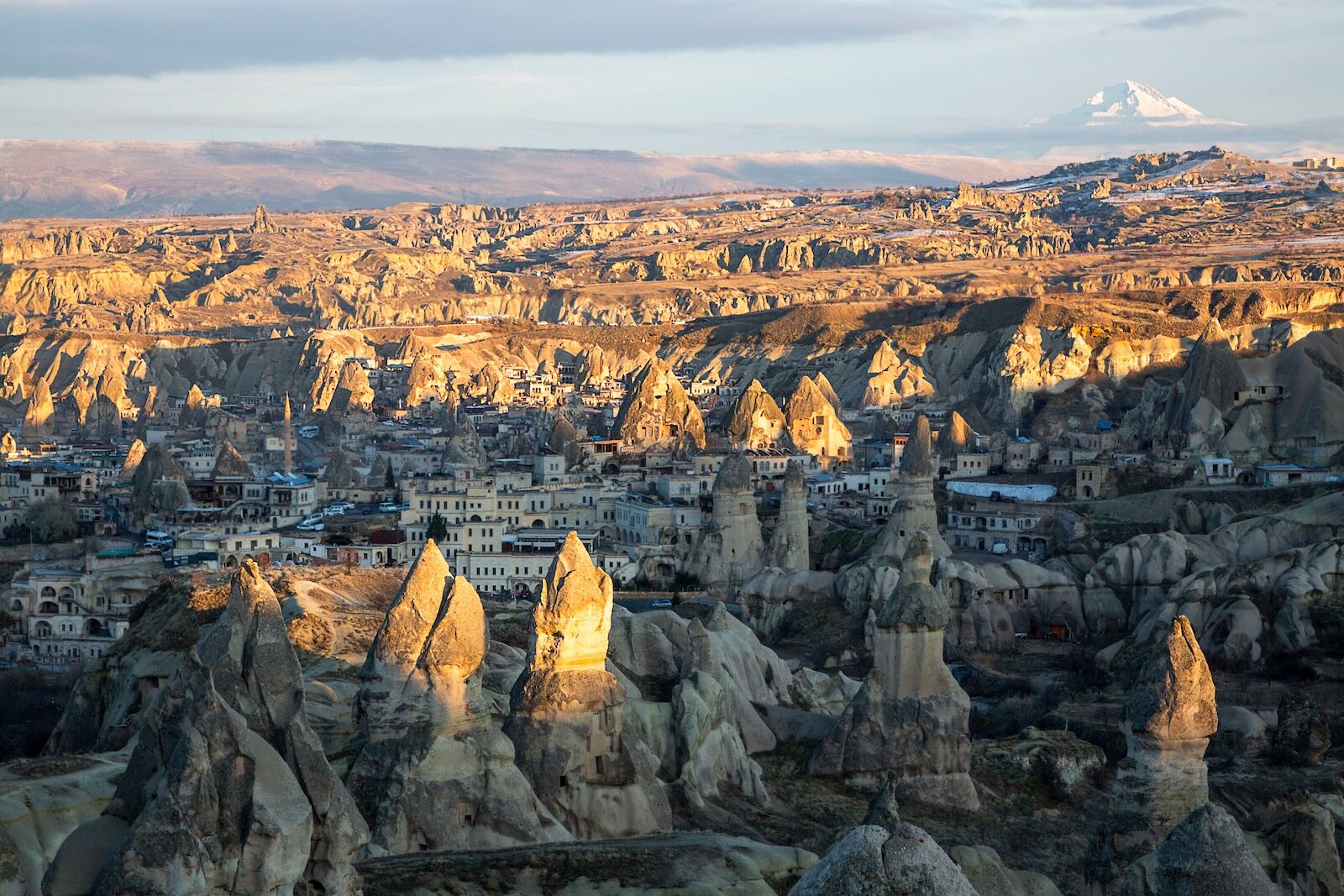I arrived at the Argos in Cappadocia hotel, in Türkiye, late at night, missing out on all the sights outside to be seen. When I woke the next morning, I stepped out on the balcony and was completely taken back by a serene and peaceful view. Hot air balloons had just started to take flight and were rising above the cliffs. As the morning went on, they started to fade behind the peak of the cliffs. It was soon apparent, however, that a balcony that looks out at Cappadocia’s famous hot air balloons is just one small facet of the draw of Argos.

Argos in Cappadocia Blends Modern Luxury With Rooms Built Right Into an Historic Cave
The history of Argos is quite remarkable. In 1996, a home was originally planned for the property. Early in the construction, workers found tunnels that turned out to be part of an ancient monastery complex. The project quickly evolved. With the guidance of skilled architects, historians, and a heritage preservation team, the caves were restored back to life and it was clear that making this a home for just one family to enjoy was not enough. The experience they had uncovered needed to be shared, and this is when Argos came to be.
Throughout history, Cappadocia’s caves served different purposes. Historians trace back the first use of the caves to the Hittites around 1800 BCE, when they were used for homes and storage. The next inhabitants of the dwellings were early Christians trying to escape persecution in the second and third centuries CE, and the structures were transformed into hidden places of worship and monastic communities. Then came the Byzantine era through the 15th century. Cappadocia remained a religious and cultural hub, and residents carved churches, monasteries, and dwellings into the cave. During the Seljuk and Ottoman Periods from the 11th to 20th century, the caves had diverse roles including housing, storage, and pigeon houses.
Today, that history and original architecture guides the modern Argos in Cappadocia. Spanning more than 145,000 square feet, each of the hotel rooms were meticulously carved into the soft rock while maintaining the original charm throughout the design and decor.
On that first day, the light exposed a ridge with unrenovated caves eroded by weather. With their color and age, they looked as if they were not of this world. As they faded off into the sunrise, I peered back to see the entrance of my room and the rest of the resort tucked into the side of the cliff at different levels. Walking back into the room, with the light fully shining in, I was able to see it what it is: a simple, yet elegant, cave that makes for a stay unlike any other.
We hope you love the spaces and stays we recommend! Just so you know, Matador may collect a small commission from the links on this page if you decide to book a stay. Listed prices are accurate as of the time of publication.
The rooms at Argos in Cappadocia
There are 51 cave suites at Argos that have all been transformed from ancient cave dwellings into luxury accommodations. No two rooms at Argos are the same, as each suite is laid out based on the restoration of the cave. In the room I stayed in, a standard room that starts at 310 euros per night, there was a bedroom, living space, and bathroom. The exposed stone walls are decorated with ceramics and Anatolian textiles accents. Setting it apart, the construction crew preserved a three-foot hole in the middle of the room that was used in ancient times as a cooking space. Today, it’s covered by a plastic window to allow you to see in.
If you’re looking to splurge, Argos offers what it terms its Splendid Suites starting at 1,000 euros per night, which are more spacious cave rooms that come with a private pool and a private garden or terrace. The suites, built out into an addition of the cave dwelling, are much larger. The exact age of specific cave dwellings can vary, but historians estimate they can range from several centuries to over a millennium.
Things to do at Argos in Cappadocia
The sights start early here. Right at sunrise, more than 100 hot air balloons take flight for the first and only time of the day over the Cappadocian landscape. The soft warm colors of the rising sun and the hoodoos in the distance make for a breathtaking view. Argos is perched in the perfect location to avoid the crowds that gather to watch the balloons elsewhere while still providing a full view. They fly every day, however the best weather runs from April to November.
Sights extend beyond the early morning, too. Argos in Cappadocia has two heated outdoor infinity pools with stunning views of Mount Erciyes, and in the winter, Mount Erciyes is a snow capped winter wonderland.
Along with the beautiful sights outside, Argos also provides a step back in time within its walls. One of the highlights of my stay was taking a tour of an underground wine cellar that’s connected by a series of original tunnels. The cellar still has its original fermenting equipment, as well as traces of animal feed holes and cooking smoke along the ceiling. The tour ends inside the large chapel with a Turkish wine tasting and charcuterie board for pairing. As Turkish wines are mostly consumed domestically rather than exported, the wine tasting was an experience that can’t be found elsewhere when it comes to both the wine and the location.
Dining at Argos in Cappadocia
Argos has two exceptional restaurants on the property: Seki and Nahita. Both specialize in regional cuisine made with local ingredients — many of the ingredients are sourced from a garden conveniently located just a five-minute walk down the terraces from the hotel lobby. Fresh produce — apples, tomatoes, lavender, and so much more — is harvested between June and October, and during the rest of the year, the hotels restaurants use dried or fermented versions. Additional ingredients are sourced from the surrounding region within a 35 mile radius.
The word seki translates to terrance. It’s a fitting name for the restaurant, as it pours out from within the cave onto its own terrace for outdoor seating. Seki sits just above the veranda of the garden, meaning the food only has to make a short trip. Nahita sits farther up the hillside, making the trip for ingredients a short number of steps longer from the garden than Seki’s. In this short distance, the menu trends toward traditional Anatolian cuisine. Each dish showcases the rich flavors of the region through spices such as cumin, coriander, sumac, mint, and parsley. Antolian cuisine has a diverse influence of flavors from Central Asia, the Middle East, Balkan, and the Mediterranean.
At Nahita, don’t miss the tzatziki — an elevated take on traditional tzatziki with the unexpected additions of plum, nectarine, green almond, and strawberry. The lamb chops are grilled to perfection and delivers a mouthwatering combination of smoky char, tender meat, and a ton of garlic. Both restaurants also have a lounge area. At Nahita it’s located above their restaurant and makes a perfect lavender martini using a lavender syrup using herbs from the hotel’s garden.
What to do in the area

Photo: MehmetO/Shutterstock
Although Cappadocia is known for its hot air balloon rides there is so much more to do in this region. Just a short drive from Argos, check out the town of Göreme and the Göreme Open Air Museum. Göreme is a charming town with cave architecture, and a perfect place to immerse yourself in local culture. The town is famous for its fairy chimneys, which are tall and thin rock formations formed by erosion. These whimsical structures contribute to the town’s surreal appearance and many of the buildings in this town are carved into the rock.
The Göreme Open-Air Museum in Cappadocia is a UNESCO World Heritage Site with century old cave churches, monasteries, and religious residences meticulously carved into the rock formations. These structures date back to the Byzantine period and served as a hub for worship, meditation, and communal living. As you explore the museum, you step back in time, surrounded by rock-cut churches and incredible artistry. The vivid frescoes inside the caves illustrate biblical scenes, crafted for educational and religious purpose.
After taking in the sights, there are many souvenir shops in the area and you can find an array of handmade carpets, ceramics, pottery, and jewelry. Pottery production is very popular in this region and has a history in the region just as old as the caves that house Argos. Turkish and international restaurants are plentiful, and don’t miss out on finding a spot to pick up a juice made with Türkiye’s famous pomegranates, which have a delicious sweet yet tart flavor to them.
How to get to Argos in Cappadocia
The best way to get to Argos in Cappadocia from the United States is to first fly to Istanbul. From there, catch a one-hour flight to the Kayseri Airport. Taxis and a shuttle bus can be reserved ahead for the transfer to the hotel, which takes just over an hour.